Amanohashidate Monju Sightseeing Route (Amanohashidate Station side)
1.Amanohashidate View Land
Amanohashidate was designated as a Place of Scenic Beauty by the government in 1922 and then as a Special Place of Scenic Beauty in 1952. Amanohashidate View Land, which is located on the top of Mt. Monju, is an observatory park with panoramic views of Amanohashidate, one of Japan’s three most scenic spots. When you do Matanozoki (bending down and looking at the scenery from between your legs) on the Matanozoki platform, Amanohashidate looks like a skyward dragon, which is why the view is also called Hiryukan (sight of a skyward dragon). The park features a Ferris wheel, cyclecars and other rides and is fun for everyone, from small children to the elderly.
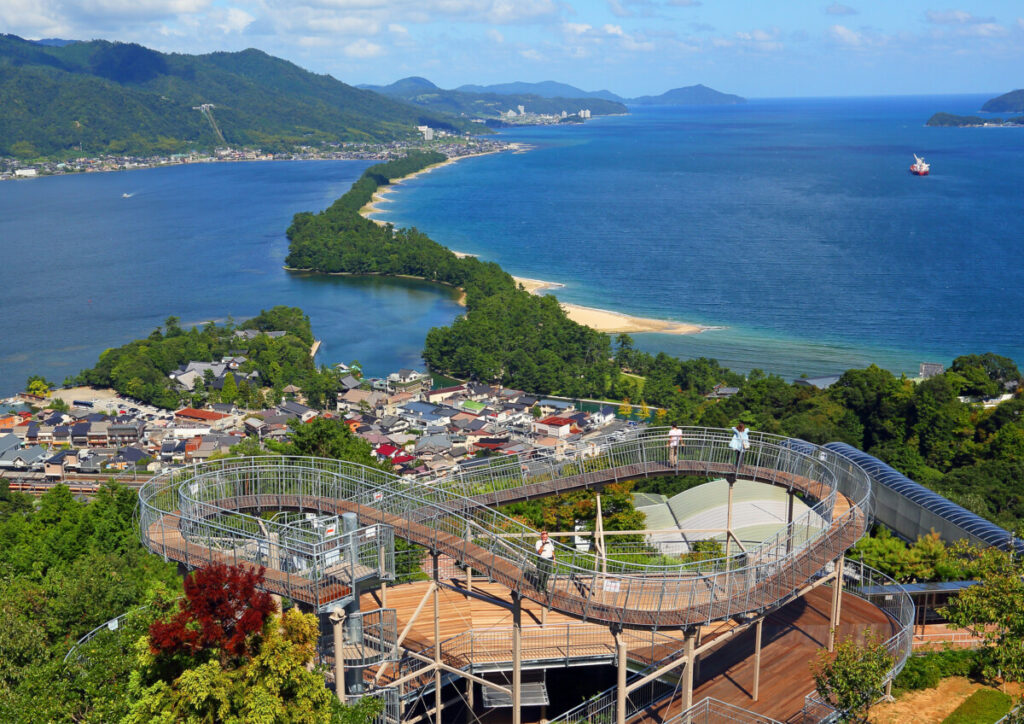
2.Donbuchi Pond
Donbuchi Pond is located behind Amanohashidate Station. There used to be funaya, traditional boathouses, and people would go to tend their fields or go fishing by boat. The pond is an area excluded from land reclamation and remains as a vestige of the estuary.
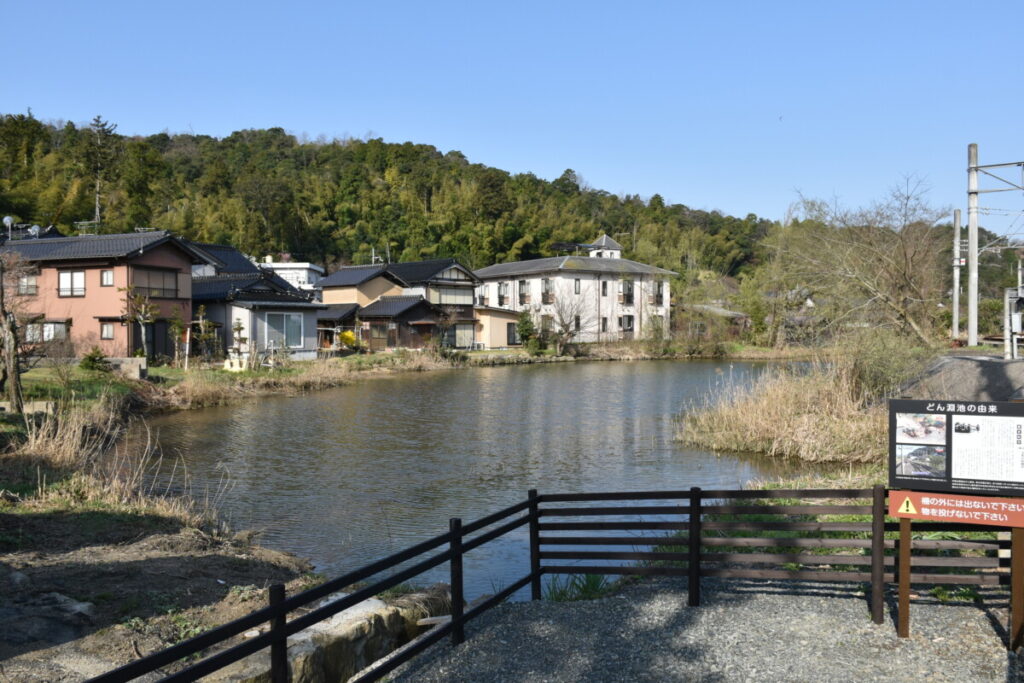
3.Chaya-dori
Chaya-dori is a street in front of the gate to Chionji Temple, and is lined with souvenir shops, bike rental shops, and restaurants. Among them are Shiken-Chaya (four teahouses), namely Yoshino Chaya, Hikobei Chaya, Kanshichi Chaya, and Chitose Chaya, which serve chie no mochi (literally “rice cake of wisdom”). This is a soft rice cake topped with koshi-an (sweet bean paste). Chie no mochi, one of Amanohashidate’s specialties, dates back to the Edo period and is said to bring wisdom to those who eat it. The dock for the sightseeing boat is down this street.
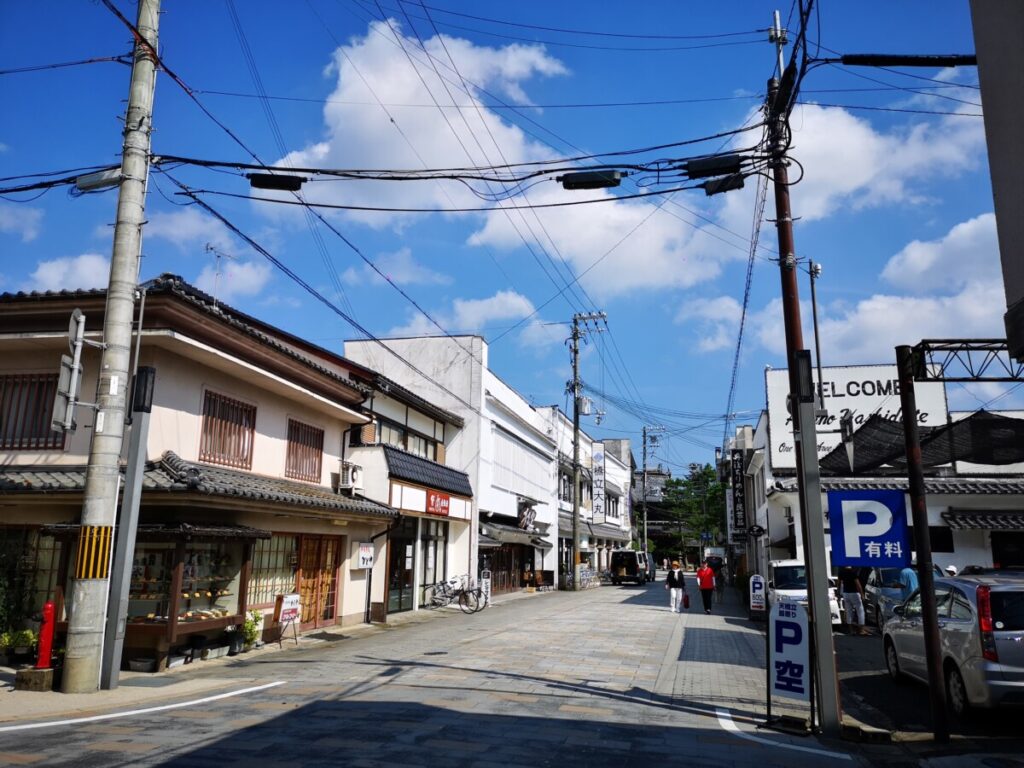
4.Chionji Temple Gate
The soaring gate at the entrance of Chionji Temple is the biggest temple gate in the Tango region and is designated as a cultural property of Kyoto Prefecture. The gate was rebuilt in 1767, and took a total of 8,780 carpenters to complete. It is constructed in the authentic Chinese style (Zen style) with scrupulous attention to detail and is well worth seeing. On top of the gate stand the statues of Shaka Nyorai (Buddha) and Juroku Rakan (16 arhats). The gate is also called Ogonkaku (golden tower) because the Empress Go-Sakuramachi donated gold for its reconstruction. It is about a five-minute walk from Amanohashidate View Land Sanroku Station.
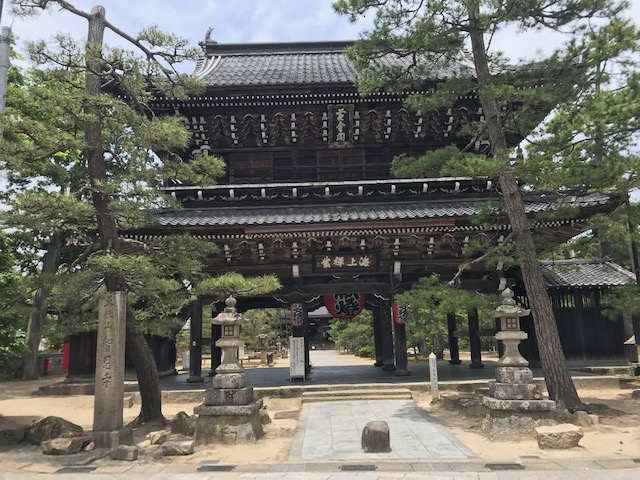
5.Chionji Temple
Chionji Temple is one of Japan’s three temples dedicated to Monju Bodhisattva and is commonly called Kireto (or Kuzeto) Monjudo Hall. Monju is well known as a Buddha that bestows wisdom as found in the saying “Sannin yoreba monju no chie” (two heads are better than one). Students preparing for exams and their parents visit the temple. The temple boasts many important cultural properties, including the main hall and the Tahoto Pagoda, which is a National Important Cultural Property. Ashikaga Yoshimitsu, the shogun at that time, often visited Amanohashidate, which led to the creation of Noh plays such as “Tango monogurui,” “Kusenoto,” and “Oeyama,” and the performance of Noh by Zeami. The Defune festival (sailing out festival) is held on July 24 and the Toka Ebisu festival on January 10.
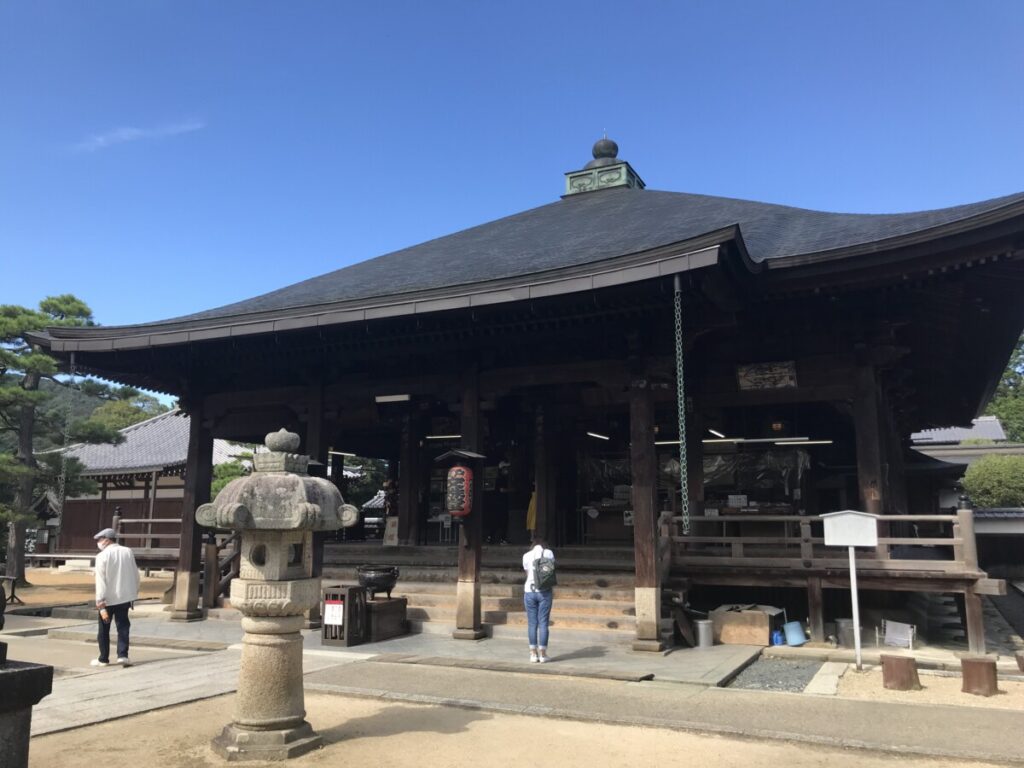
6.Chie no Wa Stone Lantern
The Chie no Wa (circle of wisdom) stone lantern is an odd-shaped lantern standing beside Chionji Temple. It is said to be used in the Edo period to guide ships sailing the Monju waters (Amanohashidate channel) with the light in the ring illuminating the dark. Another folklore says that the lantern was lit to invoke the dragon god in a legend of Amanohashidate. It is said that passing through the ring three times will make you wiser.
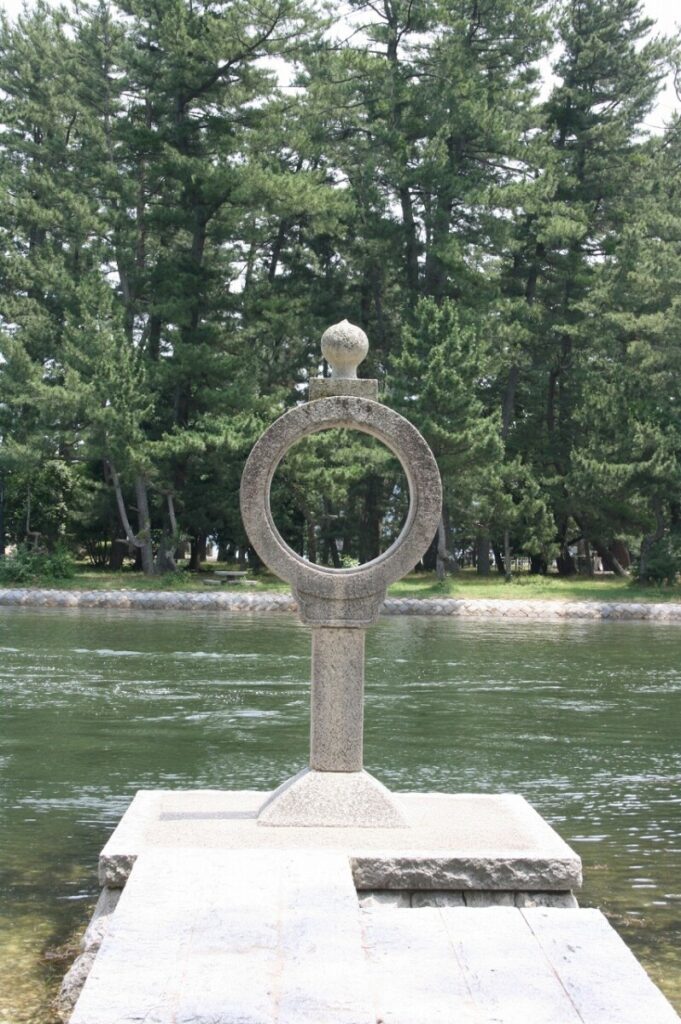
7.Kaisenkyo (Rotating Bridge)
Kaisenkyo, a rotating bridge, is the gateway to the other side of Amanohashidate when walking or cycling along the row of pine trees on the sandbar. It is an unusual bridge that turns 90 degrees every time a ship passes through. It connects Amanohashidate and the Monjudo area. The original hand-operated bridge, designed by Kyoto University professor Kondo Yasuo, was built in 1923 at a cost of 26,000 yen (at that time). As more and more large ships needed to pass under the bridge, the present electric bridge was built in May 1960. The turning bridge is fun to watch and is a good photo spot for tourists. The bridge is 36.63 m long, 3.50 m wide and 1.86 m high above sea level.

8.Amanohashidate Promenade (Pine tree street)
Amanohashidate is the perfect place to enjoy nature, including admiring the views from lookout points, strolling through the pine trees and swimming at the beach. Amanohashidate is a sandbar of about 20 to 170 m in width and about 3.6 km in overall length with some 8,000 black pines of varying sizes, creating an unusual landform. It has been molded into this mysterious shape by natural forces over thousands of years. Along the street, there are teahouses that also serve meals, historic sites, Meimeimatsu (named pine trees), and many other natural and cultural attractions. It takes about 50 minutes on foot or 20 minutes by bike each way. The promenade is closed to cars.
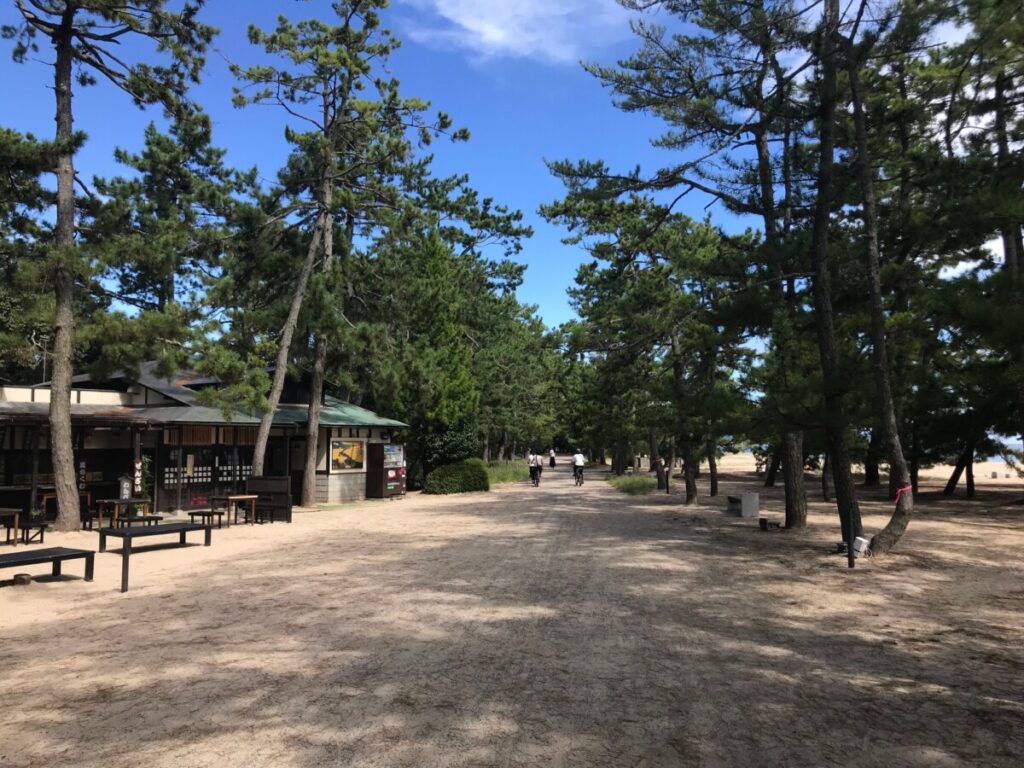
9.Monument of Japan’s Three Most Scenic Spots
Along Amanohashidate promenade stands a monument marking Japan’s three most scenic spots, namely Amanohashidate, Miyajima and Matsushima. In July 2006, Nihon Sankei Kanko Renraku Kyougikai designated July 21, the birthday of Hayashi Shunsai, as the day of the three most scenic spots.
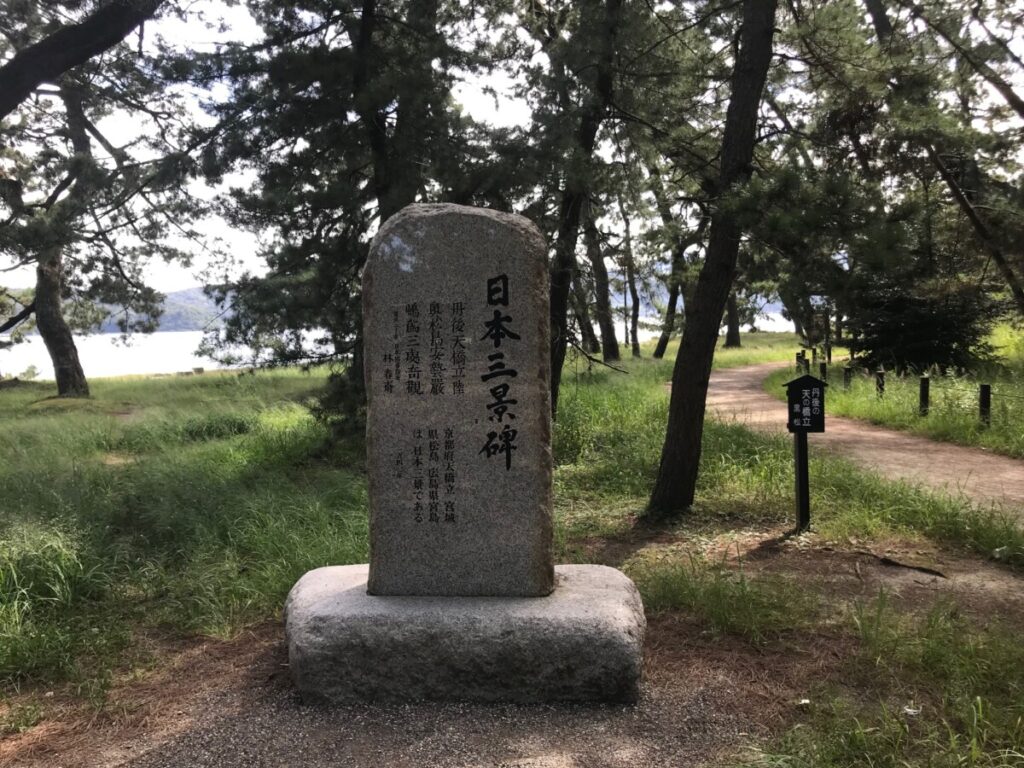
10.Monument of Japan’s 100 Best Roads
The monument of Japan’s 100 best roads stands near the Daitenkyo bridge. Amanohashidate features on various top 100 lists of Japan, such as the 100 best pine trees, 100 best waters, 100 best roads, 100 best beaches with white sand and green pines, 100 best beaches, 100 most beautiful historical sites, 100 best historical parks, and 100 best geological sites.
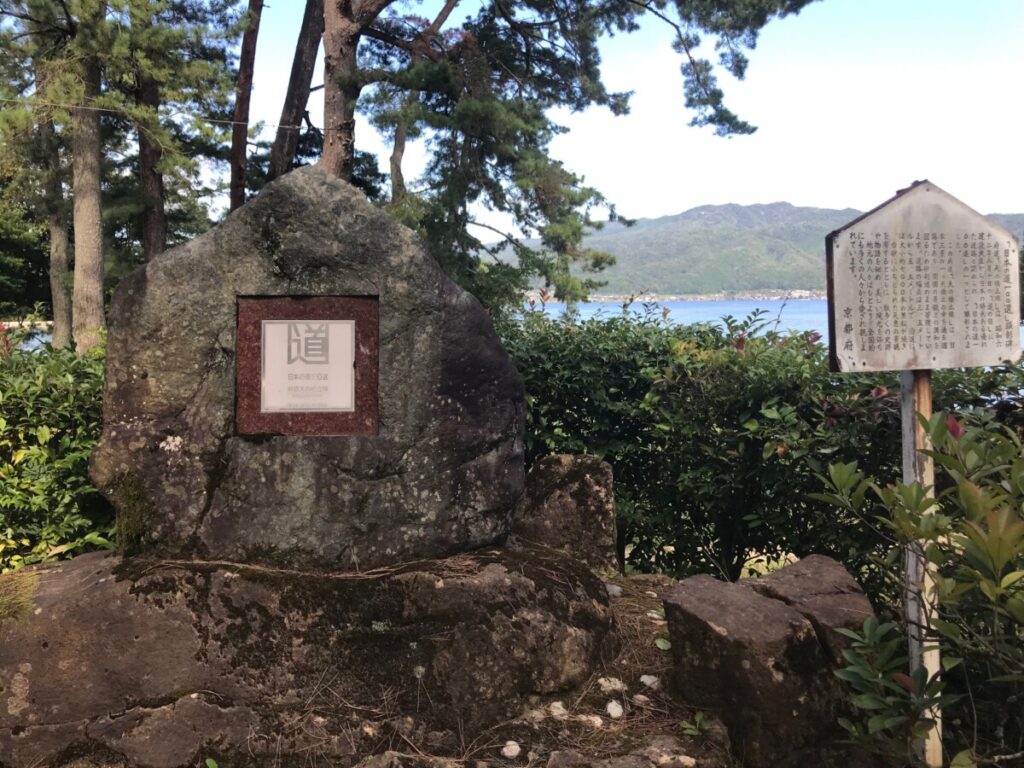
11.Monument to Yosano Hiroshi and Akiko
Yosano Akiko, a pioneer of modern tanka poetry, visited Amanohashidate with her husband Hiroshi many times and wrote many poems. This monument inscribed with their poems was erected at Amanohashidate in 2006. Since ancient times, Amanohashidate has been known as a place inhabited by gods; accordingly, many writers and artists including Izumi Shikibu, a poet in the Heian period, visited the place and wrote many tanka and haiku poems.
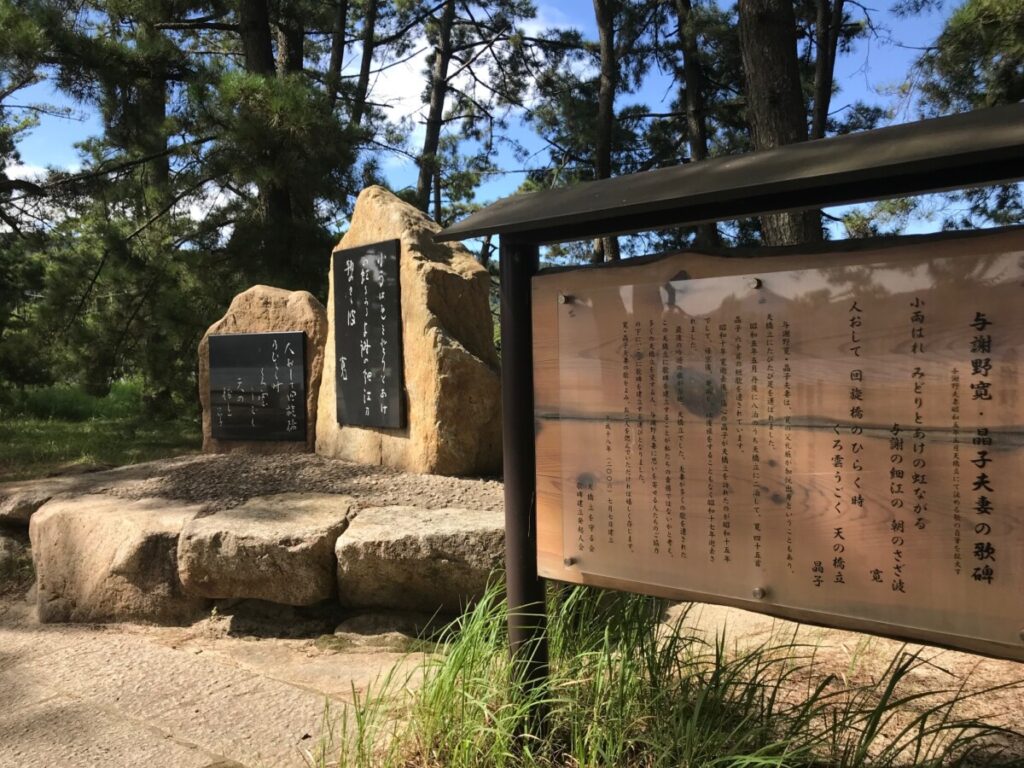
12.Iwami Jutaro’s Sword Testing Stone / Site of Iwami Jutaro’s Revenge
This is the place where Iwami Jutaro, a famous swordsman, is said to have avenged his father’s death by killing the three murderers Hirose Gunzo, Naruo Gonzo and Okawa Hachizaemon.
Legend has it that Iwami Jutaro came to Miyazu in Tango in pursuit of the three men. Fearing for their lives, they hid in the house of their lord, the Kyogoku Family. Iwami asked the Kyogoku Family for permission for revenge and it was granted. Iwami finally killed them at Atsumatsu in Amanohashidate on September 20, 1632. Iwami Jutaro is believed to be the same person as Susukida Kanesuke. Susukida was a vassal of the Toyotomi Family, and is said to have distinguished himself in the winter battle of Osaka and died in the summer battle. Here can be found the stone on which Iwami tested his sword.
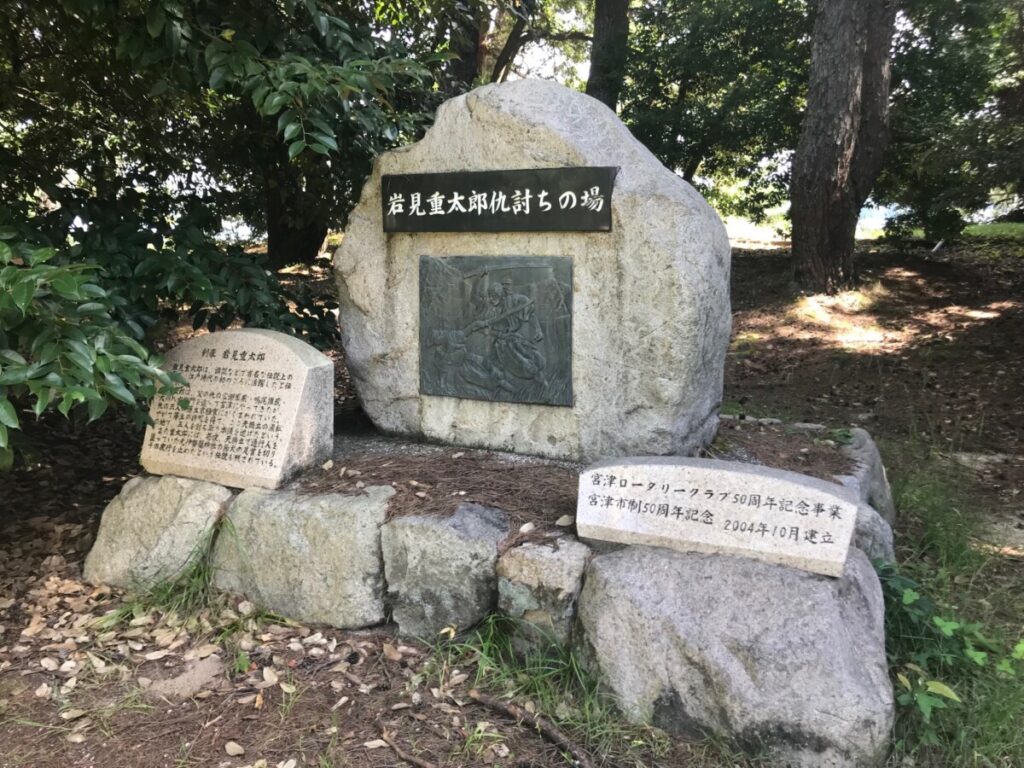
13.Isoshimizu
Isoshimizu is a spring which curiously yields fresh water containing no salt at all despite being in an area surrounded by the sea. Isoshimizu was chosen as one of Japan’s 100 best waters by the Ministry of the Environment in 1985. The spring is also used as purifying water before entering the nearby shrine (it is not potable).
Izumi Shikibu, a poet in the Heian period, also used Isoshimizu when she visited Amanohashidate and wrote a poem about the spring.
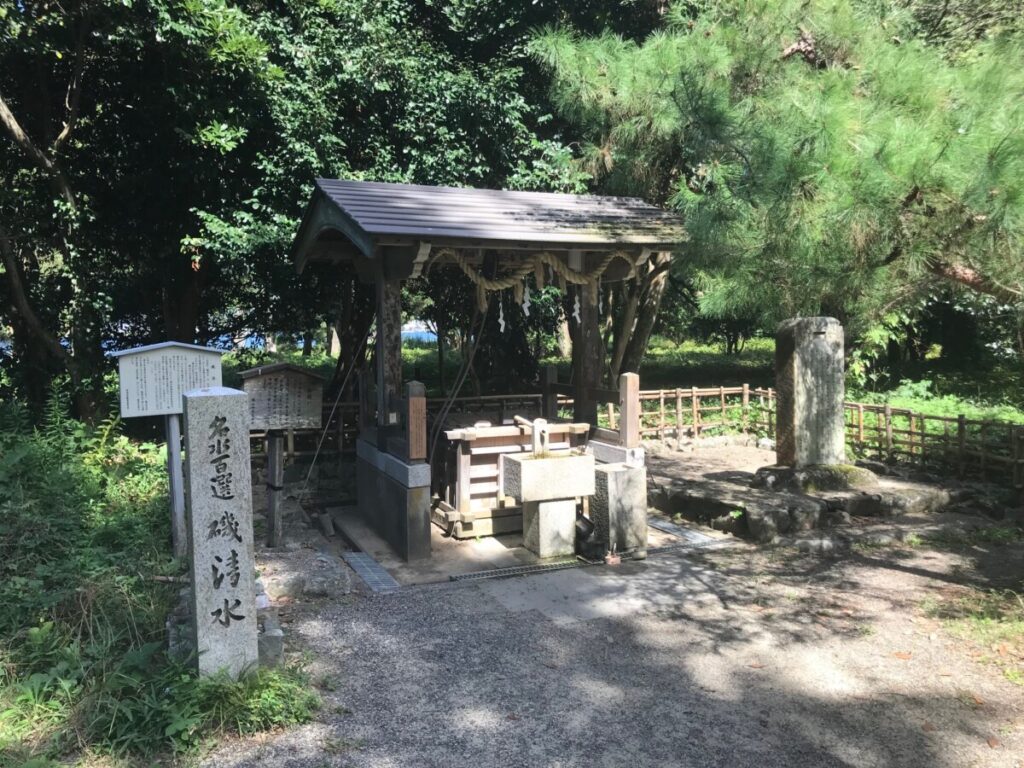
14.Amanohashidate Shrine (Hashidate Myojin)
Nestled in Amanohashidate sandbar is a quaint shrine that is a popular spiritual site for love relationships. Amanohashidate is host to many stories about dragons, and Hachidai Ryuo, the eight dragon kings, are enshrined here. Legend has it that this shrine was originally Motoise and Motoise was relocated from here. However, it is considered to be a tutelary shrine of Monjudo. Before the sandbar reached the south in the late Edo period, people landed on Atsumatsu when coming to Amanohashidate from Monju by boat. Amanohashidate Shrine was considered to be located in an important area as the gateway to Amanohashidate and Fuchu. It is noteworthy that the shrine has been worshipped since long ago. The stone torii gate stands overlooking Asonoumi, a lagoon, which suggests the connection between the shrine and the sea. The shrine is about a 15-minute walk from Kaisenkyo.
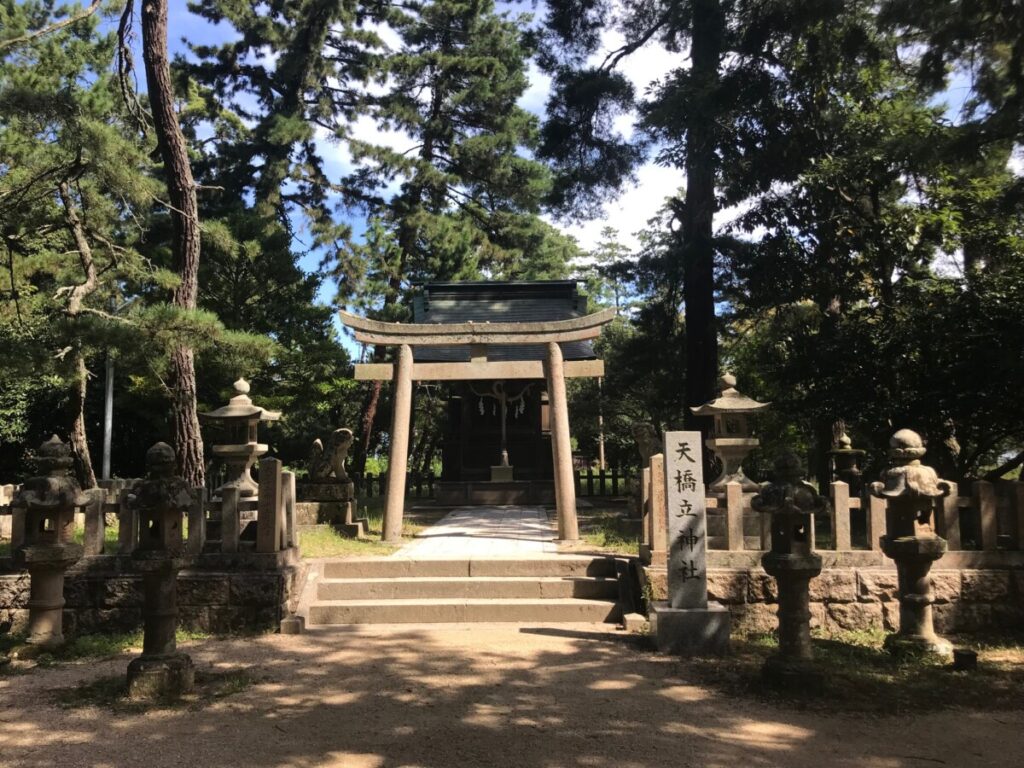
15.Amanohashidate Station Road
The main street in front of Amanohashidate Station is lined with restaurants, souvenir shops, and hotels, as well as parking lots. Amanohashidate Station has large baggage lockers and a tourist information office. The station is located near Amanohashidate Onsen “Chie-no-yu,” a hot spring.
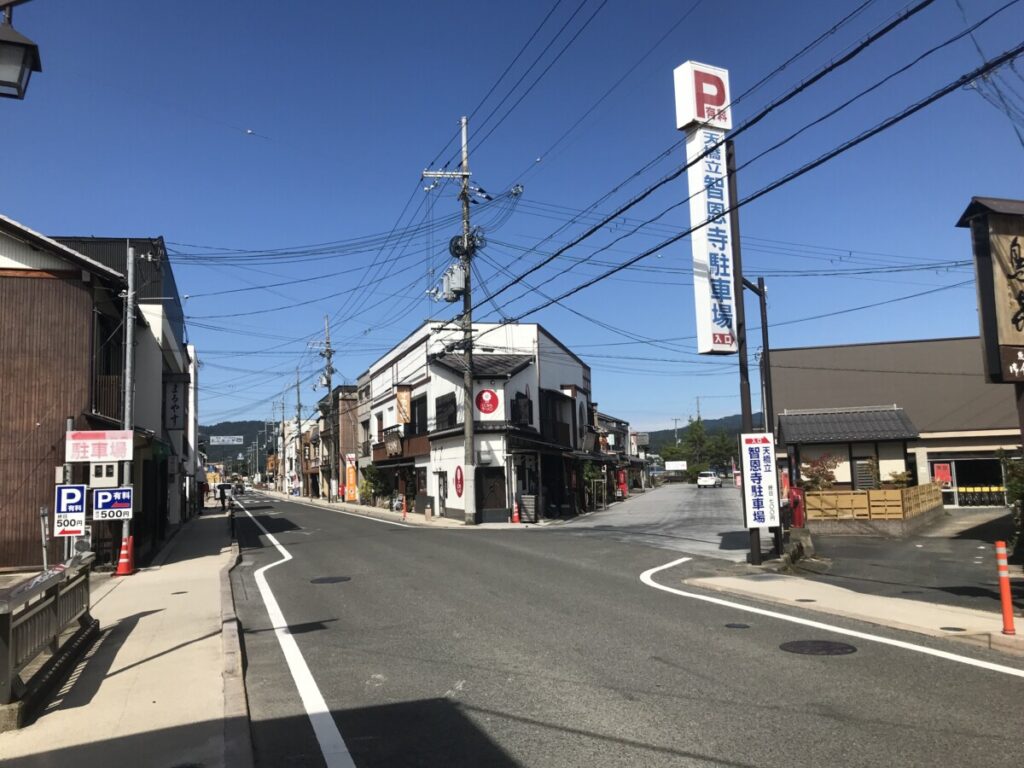
16.Amanohashidate Onsen “Chie-no-yu”
“Chie-no-yu” is a hot spring (onsen) located next to Amanohashidate Station. The hot spring was given this name in the hope that all visitors will be blessed with good health and wisdom (chie) by Monju Bodhisattva of Chionji Temple (“yu” means hot water). The hot spring is built in Japanese style modeled on a traditional townhouse. The bathtub is partly made of pine trees from Amanohashidate. The silky smooth spring water is said to be gentle and good for the skin and beauty, making it the perfect place to wrap up your trip.
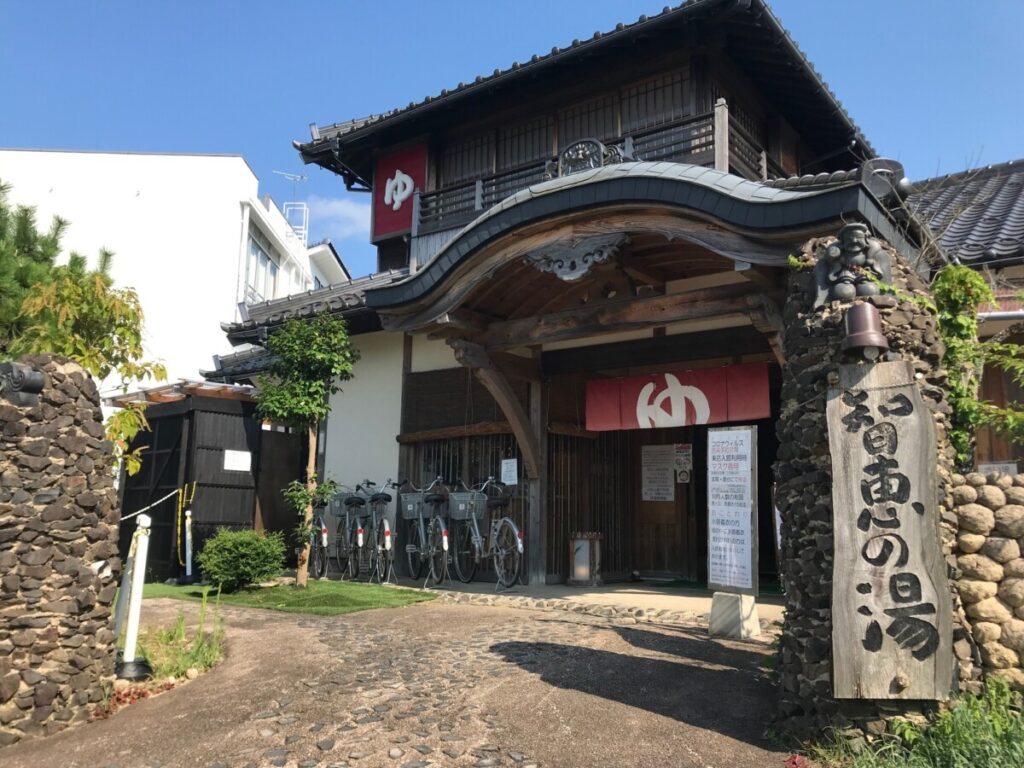
Amanohashidate Sightseeing Route (including the other side)
1.Amanohashidate View Land
Amanohashidate was designated as a Place of Scenic Beauty by the government in 1922 and then as a Special Place of Scenic Beauty in 1952. Amanohashidate View Land, which is located on the top of Mt. Monju, is an observatory park with panoramic views of Amanohashidate, one of Japan’s three most scenic spots. When you do Matanozoki (bending down and looking at the scenery from between your legs) on the Matanozoki platform, Amanohashidate looks like a skyward dragon, which is why the view is also called Hiryukan (sight of a skyward dragon). The park features a Ferris wheel, cyclecars and other rides and is fun for everyone, from small children to the elderly.

2.Amanohashidate Rent-a-Car
If you are considering touring by car, Amanohashidate Rent-a-Car is located in front of Amanohashidate Station. It is convenient for sightseeing on the other side of Amanohashidate (including Motoise Shrine, Kasamatsu Park, and Nariaiji Temple), Inecho and Kyotango city.
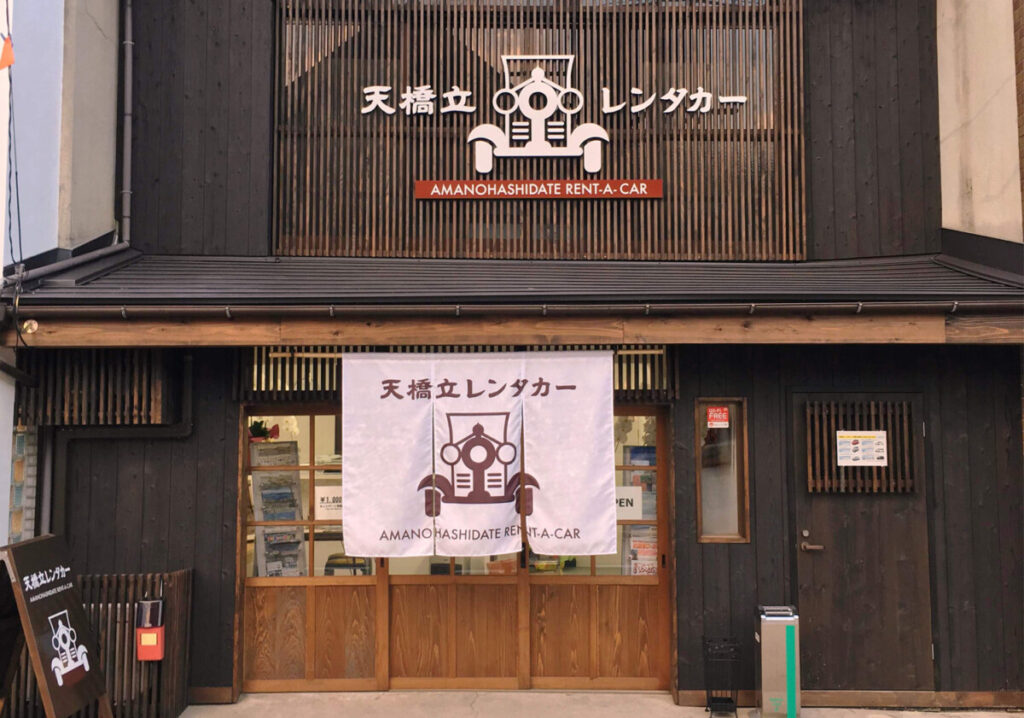
3.Chaya-dori
Go down the Chaya-dori street in front of the Chionji Temple gate to go sightseeing on the other side of Amanohashidate on foot, rental bike, or sightseeing boat. You will find rent-a-bike shops and the dock for sightseeing boats.
Among them are Shiken-Chaya (four teahouses), namely Yoshino Chaya, Hikobei Chaya, Kanshichi Chaya, and Chitose Chaya, which serve chie no mochi (literally “rice cake of wisdom”). This is a soft rice cake topped with koshi-an (sweet bean paste). Chie no mochi, one of Amanohashidate’s specialties, dates back to the Edo period and is said to bring wisdom to those who eat it.

4.Chionji Temple
Chionji Temple is one of Japan’s three temples dedicated to Monju Bodhisattva and is commonly called Kireto (or Kuzeto) Monjudo Hall. Monju is well known as a Buddha that bestows wisdom as found in the saying “Sannin yoreba monju no chie” (two heads are better than one). Students preparing for exams and their parents visit the temple.
The temple gate facing Chaya-dori, also known as Ogonkaku (golden tower), is a designated cultural property of the city. On top of the gate stand the statues of Shaka Nyorai (Buddha) flanked by Ryo Kyoji (two attendants) and Juroku Rakan (16 arhats). The two-story gate with three bays and three entrances in Zen style is the biggest temple gate in the Tango region. The temple boasts many important cultural properties, including the Tahoto Pagoda, which is a National Important Cultural Property.
The temple boasts many important cultural properties, including the main hall and the Tahoto Pagoda, which is a National Important Cultural Property. Ashikaga Yoshimitsu, the shogun at that time, often visited Amanohashidate, which led to the creation of Noh plays such as “Tango monogurui,” “Kusenoto,” and “Oeyama,” and the performance of Noh by Zeami. The Defune festival (sailing out festival) is held on July 24 and the Toka Ebisu festival on January 10.

5.Amanohashidate Sightseeing Boat Dock
This is the boarding point for the sightseeing boat operating between Monju and Ichinomiya, which is the perfect way for sightseeing in Amanohashidate.
The Amanohashidate sightseeing boat connects the two coasts at both ends of the pine tree street, that is, the Monju area and the Fuchu area, taking 12 minutes each way. You can enjoy feeding the seagulls onboard while the boat sails along the sandbar. You can also ride a motorboat from the nearby dock. The sightseeing boat dock is about a five-minute walk from Amanohashidate View Land Sanroku Station.
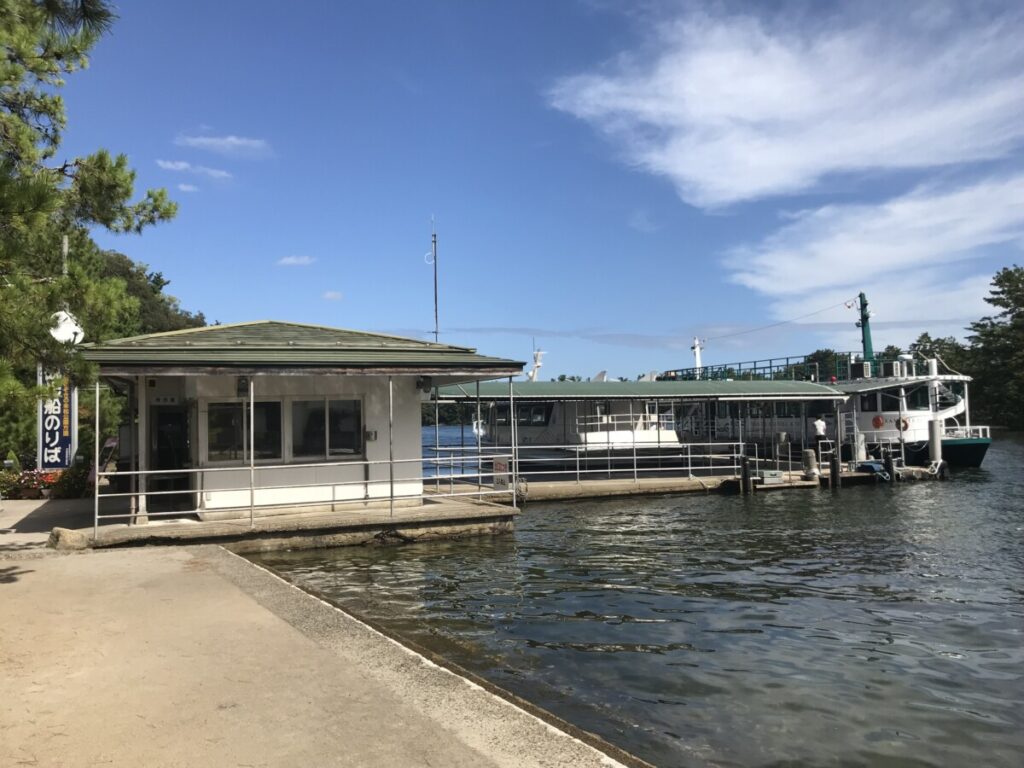
6.Kaisenkyo (Rotating Bridge)
Kaisenkyo, a rotating bridge, is the gateway to the other side of Amanohashidate when walking or cycling along the row of pine trees on the sandbar. It is an unusual bridge that turns 90 degrees every time a ship passes through. It connects Amanohashidate and the Monjudo area. The original hand-operated bridge, designed by Kyoto University professor Kondo Yasuo, was built in 1923 at a cost of 26,000 yen (at that time). As more and more large ships needed to pass under the bridge, the present electric bridge was built in May 1960. The turning bridge is fun to watch and is a good photo spot for tourists. The bridge is 36.63 m long, 3.50 m wide and 1.86 m high above sea level.
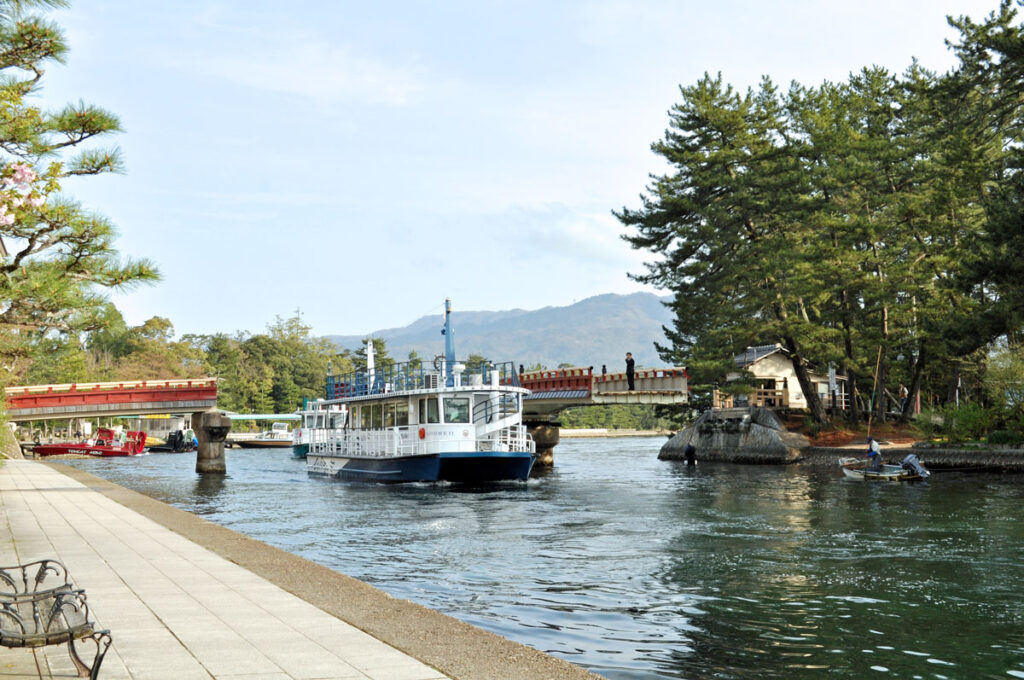
7.Amanohashidate Promenade (Pine tree street)
Amanohashidate is the perfect place to enjoy nature, including admiring the views from lookout points, strolling through the pine trees and swimming at the beach.
Along the promenade, there are Hashidate Chaya (a teahouse that also serves meals), Isoshimizu which is designated as one of Japan’s 100 best waters, Hashidate Myojin dedicated to Hachidai Ryuo, the monument inscribed with a poem of Emperor Showa at his visit, those inscribed with poems of Yosa Buson and Matsuo Basho, Meimeimatsu (named pine trees), and many other natural and cultural attractions. The promenade is 3.6 km in length and it takes about 50 minutes on foot or 20 minutes by bike each way. The promenade is closed to cars.

8.Amanohashidate Activity Center
An activity facility run by the Amanohashidate Tourism Association. The Center offers a range of activities including sea-kayaking. Bookings can be made on the official website.
Same-day bookings are available. For details, see the official website.
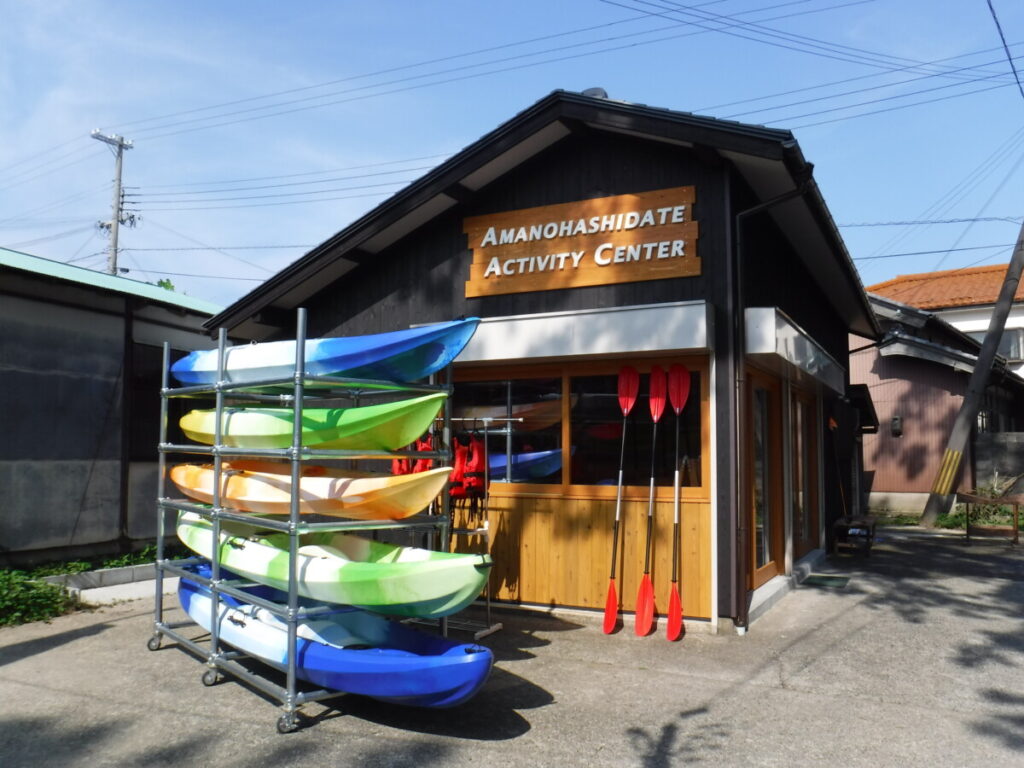
9.Motoise Kono Shrine
The name of this old shrine moto-ise (former Ise) comes from a myth narrating that the sun goddess Amaterasu-Omikami and the goddess of agriculture Toyouke-no-Omikami currently enshrined at Ise Shrine were moved from here to Ise. Motoise Kono Shrine is one of the most prestigious shrines in the Tango region and it owns Amabe-shi Keizu (genealogy of the Amabe Family), a National Treasure, and Shinzen no Komainu (shrine guardian dogs), an Important Cultural Property.
This shrine became the most important shrine in Tango in the Nara period and was listed as myojin taisha, the highest-ranking shrine, in the Engishiki Code in the Heian period. It is the only taisha in the San-indo area, boasting the highest ranking and a long history. Along the railing in front of the main shrine there are five-colored suetama, a Shinto motif that only two shrines in the country are permitted to use: Ise Shrine and Kono Shrine. Within the shrine grounds there is a suikinkutsu, a Japanese garden ornament that produces a beautiful sound like a koto harp as water drips into an underground cave. Its mysterious tones echo from underfoot and it is as relaxing as it is beautiful.
The legend of the floating bridge from heaven
In ancient times the god Izanagi went to and from the heavens to see the goddess Izanami in Manai Shrine, the okumiya (rear shrine) of Kono Shrine, via the Bridge to the Heavens (Amanohashidate). Today, this area is known as the land where men and women can become bound to one another like Izanagi and Izanami.
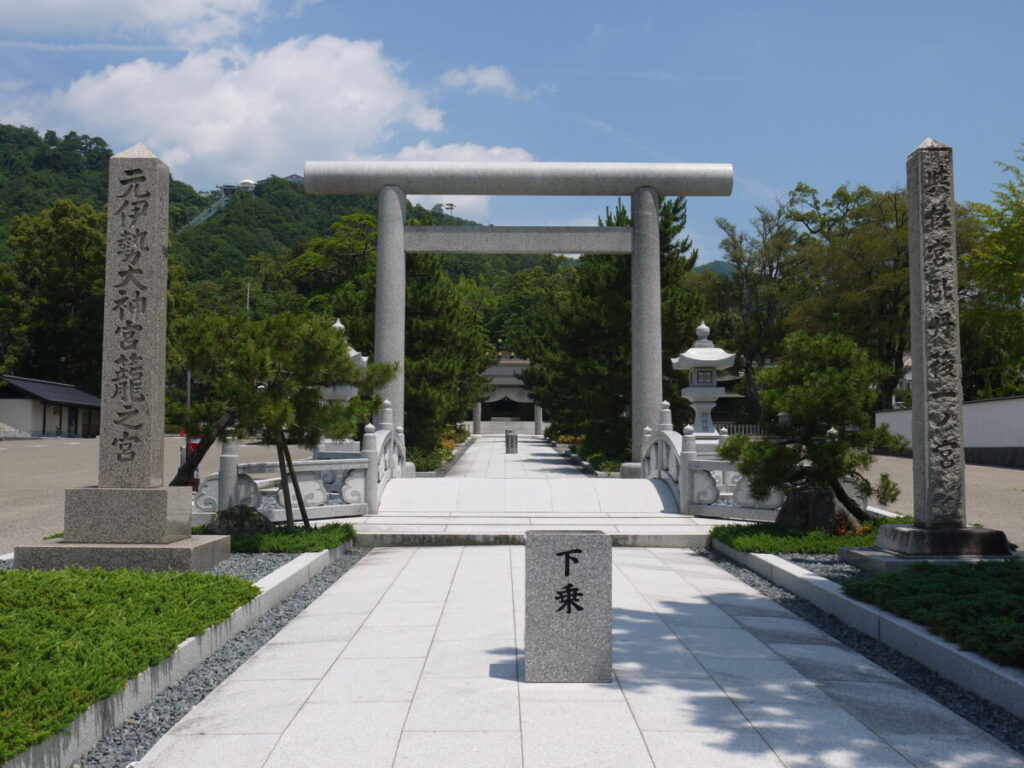
10.Manai Shrine
Manai Shrine, also known as Kushihama-no-Miya, is the okumiya (rear shrine) of Motoise Kono Shrine. Kushi means the source of mystical powers and is a place that attracts many visitors as a spiritual site.
The shrine is famous for its Iwakura, or an ancient rock thought to be the dwelling place of the gods. The rock has been preserved and worshipped in its current state for approximately 2,500 years behind the main shrine. The main gods worshipped here are Amaterasu-Omikami and Toyouke-no-Omikami.
The shrine is also famous for having pure sacred water called “Ame no Manai no Mizu.” Many people come from all over the country to collect water from this spot.
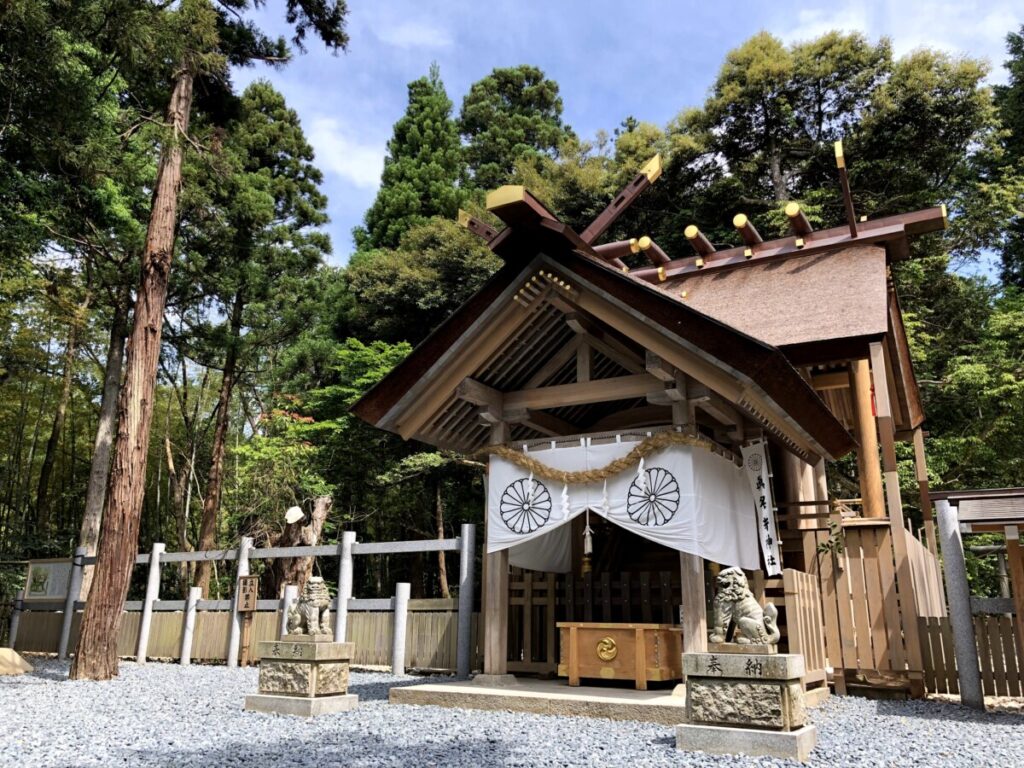
11.Kasamatsu Park
The park, located halfway up Mt. Nariai, is an observatory where you can overlook Amanohashidate from the north. Amanohashidate became a park under the control of Yosa County in 1905 and tourism development was encouraged. Fuchu Village donated the land of Kasayama and the rest house under certain conditions, and Kasamatsu Park was completed in 1919.
The view from the park is called Shoryukan (sight of an ascending dragon) as Amanohashidate looks like the shape of a soaring dragon. It is well known that Matanozoki was done for the first time here, which means to turn your back to Amanohashidate, bend over, and view it from between your legs, so that the sky and the land look upside down.
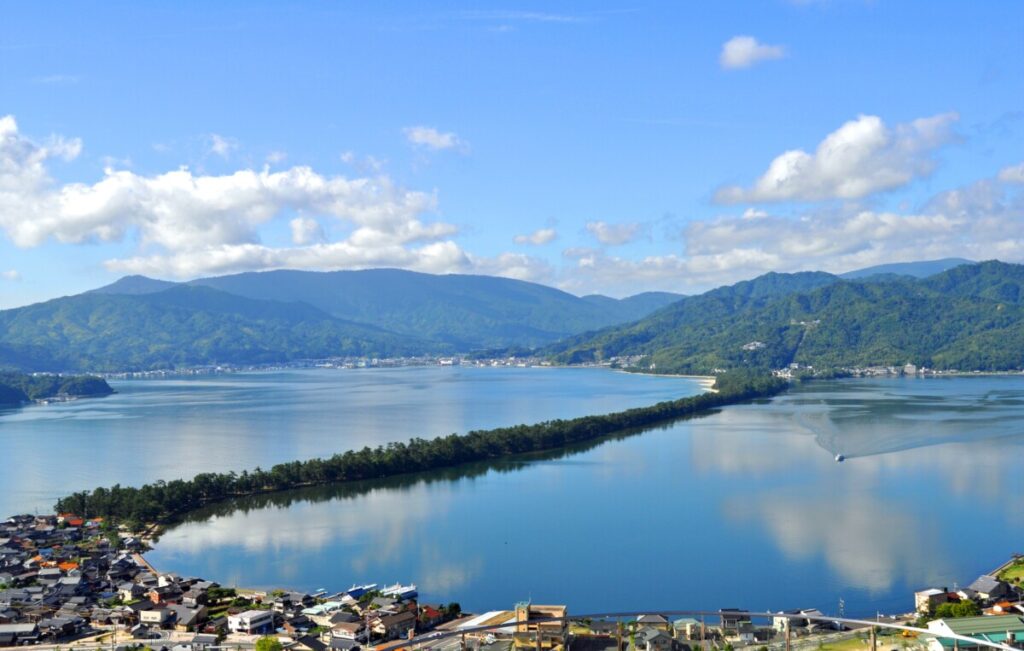
12.Nariaiji Temple
Nariaiji Temple, the 28th spot for a pilgrimage in the Kinki area, overlooks one of Japan’s three most scenic spots. The temple is famous as a place where wishes come true, according to a legend of the migawari Kannon (self-sacrificing Kannon).
The temple is dedicated to the Sho Kanzeon Bosatsu, Avalokitesvara, which takes the form of a beautiful woman. It is said that visitors to the temple are granted a beautiful body and spirit.
Nariaiji Temple is also famous for cherry blossoms and rhododendrons in the spring and Japanese maples in the autumn. The temple also features a five-story pagoda, Mamuki no Ryu (carving of a front-facing dragon) and Hitokoto Jizo (one wish, one word jizo).
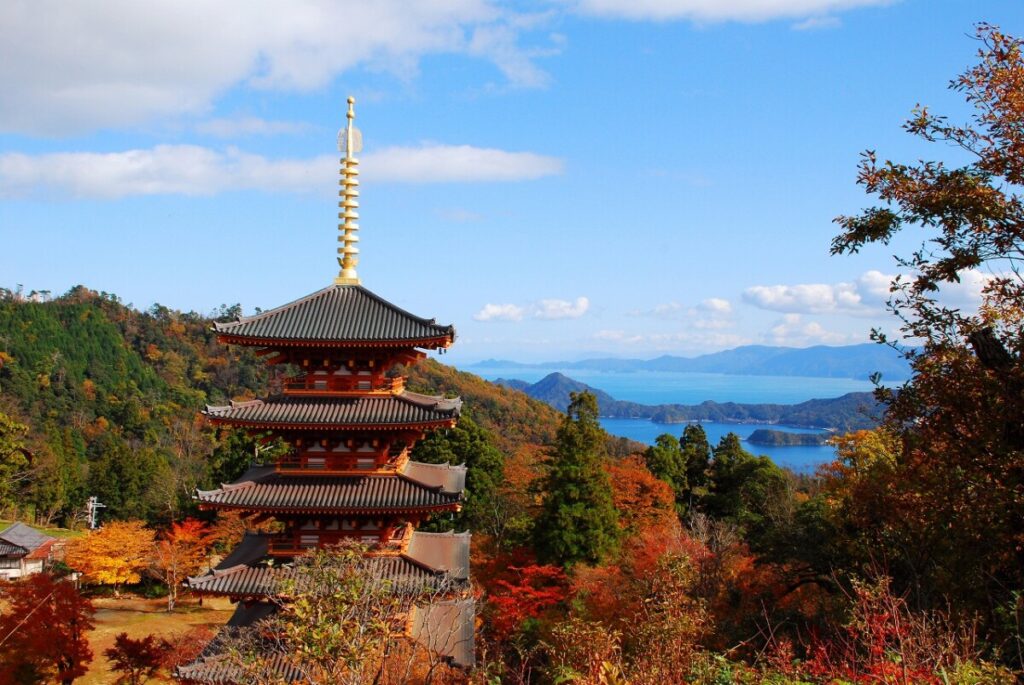
13.The remains of Tango Kokubunji Temple
The remains of the temple are located on an alluvial fan that gently slopes southward from Mt. Nariai. In the grounds of the present Shingon Buddhist Kokubunji remain cornerstones and stylobates of the main hall, pagoda, and inner gate, and slates used in the Nara period have been unearthed here. Because these finds indicate what the old Kokubunji was like, the ruins were designated as a National Historic Site in 1930. The temple is considered to have been constructed at least by the end of the 8th century although the exact date is unknown. A total of 35 cornerstones of the main hall, 16 of the pagoda, and two of the inner gate have been discovered. Except for those of the inner gate, the stones are of low quality with traces of burning by fire, which suggests that these stones were used for reconstruction in 1334, not for the initial construction. The whole premises of Kokubunji have been refurbished and are now open to the public.
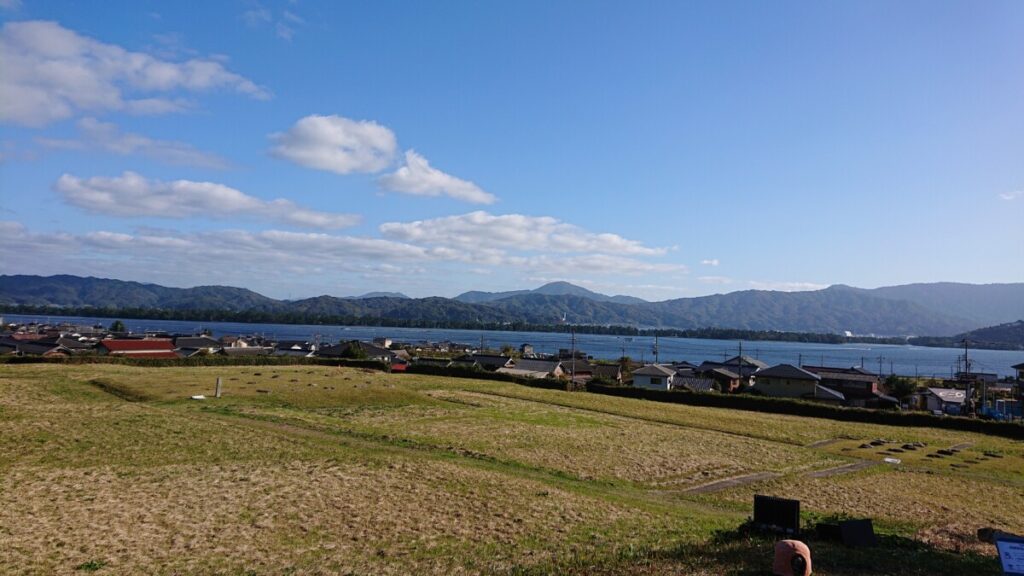
14.Kyoto Prefecture Tango Folk Museum
The prefectural museum collects, surveys, researches, and exhibits materials concerning the history, art, archeology and folklore of northern Kyoto Prefecture. The museum now houses more than 100,000 documents and items in total.
The museum displays permanent exhibits related to the history and culture of the Tango region as well as temporary themed exhibits.
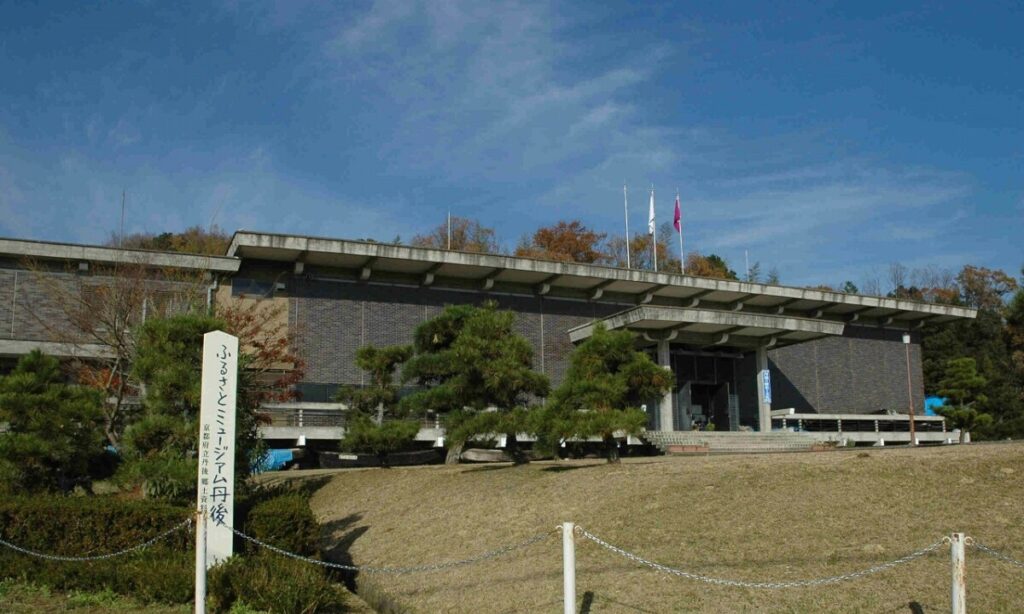
15.Amanohashidate Station Road
The main street in front of Amanohashidate Station is lined with restaurants, souvenir shops, and hotels, as well as parking lots. Amanohashidate Station has large baggage lockers and a tourist information office. The station is located near Amanohashidate Onsen “Chie-no-yu,” a hot spring.

16.Amanohashidate Onsen “Chie-no-yu”
“Chie-no-yu” is a hot spring (onsen) located next to Amanohashidate Station. The hot spring was given this name in the hope that all visitors will be blessed with good health and wisdom (chie) by Monju Bodhisattva of Chionji Temple (“yu” means hot water). The hot spring is built in Japanese style modeled on a traditional townhouse. The bathtub is partly made of pine trees from Amanohashidate. The silky smooth spring water is said to be gentle and good for the skin and beauty, making it the perfect place to wrap up your trip.













